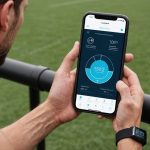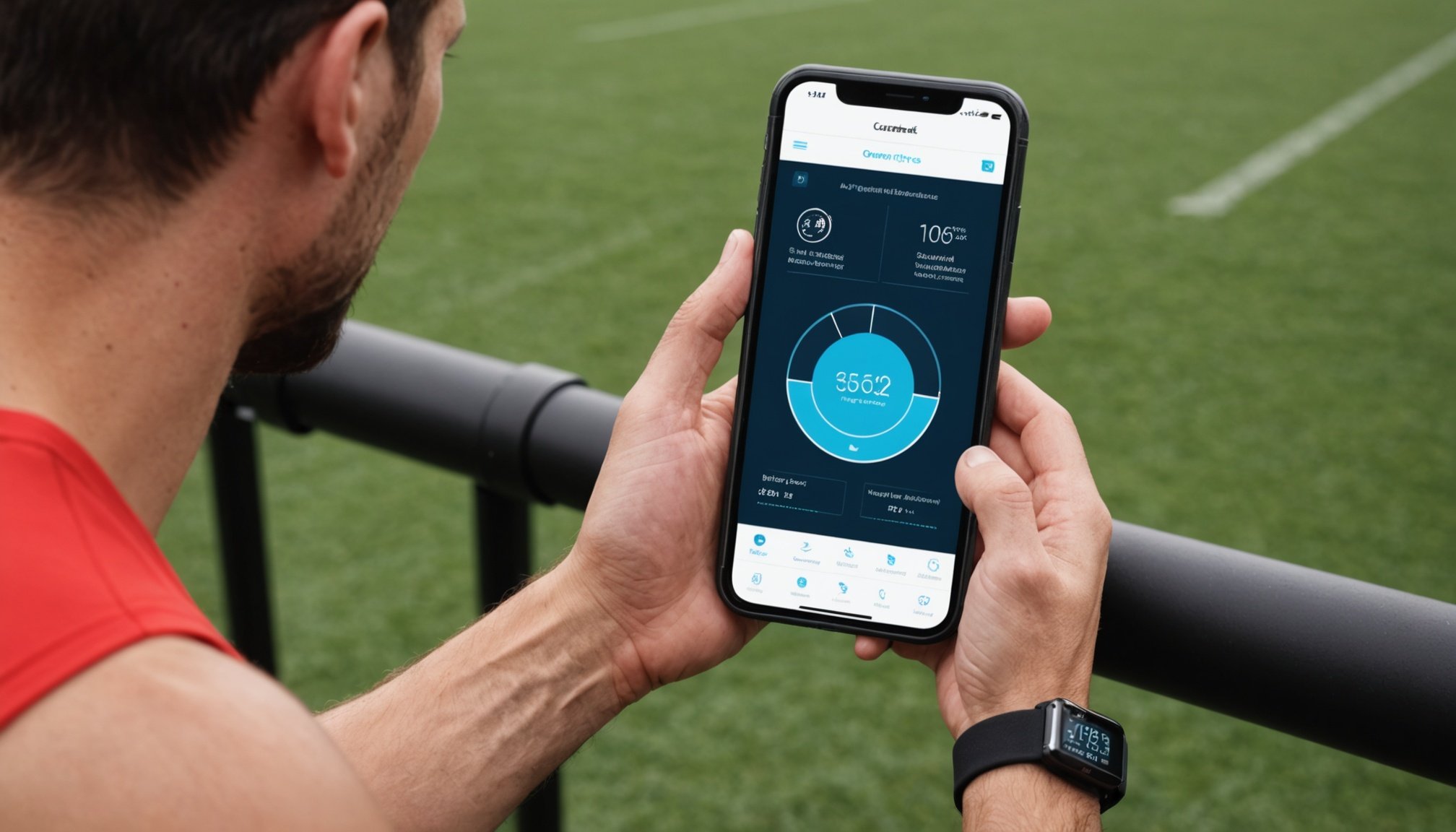Transforming Athletic Excellence: Utilizing Wearable Tech to Prevent Overtraining in Elite Athletes
In the high-stakes world of elite athletics, the margin between victory and injury can be perilously thin. The advent of wearable technology has revolutionized the way coaches, trainers, and athletes themselves monitor and manage physical exertion, making it a crucial tool in preventing overtraining and optimizing performance.
The Rise of Wearable Technology in Sports
Wearable technology, once a novelty, has become an indispensable component of modern sports training. These advanced devices, equipped with GPS trackers, accelerometers, gyroscopes, and heart rate monitors, provide a wealth of data that helps in fine-tuning athlete performance and mitigating the risk of injuries.
Additional reading : Maximize your game: harnessing the benefits of plyometric push-ups for rugby athletes
Key Components of Wearable Technology
- GPS Trackers: These track the physical movements of athletes during training sessions and matches, measuring metrics such as speed, acceleration, deceleration, and distance covered. This data is invaluable for designing effective training programs and managing fatigue[3].
- Heart Rate Monitors: These sensors calculate and display an athlete’s heart rate in real-time, allowing coaches to ensure that athletes are working within the correct training zones. For example, during pre-season training, coaches might aim for high heart rate zones to build fitness, while during the season, they might focus on lighter sessions to aid recovery[3].
- Accelerometers and Gyroscopes: These sensors track the intensity and frequency of high-impact actions, such as sharp turns and sudden stops, which are common in sports like football and basketball. This helps in identifying biomechanically inefficient movements that could lead to injuries like ACL tears and ankle sprains[1].
Monitoring and Managing Athlete Workload
Effective management of athlete workload is critical in preventing overtraining and reducing the risk of injuries. Here’s how wearable technology helps:
Load Management
- Tracking Physical Workload: Wearable devices measure running distances, sprint counts, and overall exertion, providing a comprehensive view of an athlete’s physical workload. This data helps coaches to balance the demands of training and matches with adequate recovery time[1].
- Monitoring Recovery: Metrics like heart rate variability (HRV) and sleep quality offer insights into an athlete’s readiness to perform. For instance, if an athlete’s HRV is low, it may indicate that they need additional recovery time[1].
- Periodization: Structured training cycles that alternate between high-intensity and low-intensity phases help athletes build fitness without risking burnout. Wearable technology supports this by providing real-time data on an athlete’s physical condition and recovery progress[1].
Fatigue Monitoring: The Key to Preventing Overtraining
Fatigue is a significant factor in athletic injuries, and wearable technology is designed to track signs of physical and mental exhaustion.
Also to discover : Unlocking faster transitions: key strategies for triathletes to accelerate race performance
How Fatigue Monitoring Works
- Real-Time Data Analysis: Sensors track metrics such as heart rate, movement patterns, and energy output to identify when athletes need additional recovery time. For example, if an athlete’s speed or acceleration decreases significantly, it may indicate fatigue[1].
- Cumulative Workload Assessment: Wearable devices provide insights into the cumulative workload over time, enabling coaches to make informed decisions about training intensity and match participation[1].
- AI-Driven Predictive Models: Advanced algorithms can predict fatigue and stamina by analyzing historical data, biomechanical assessments, and environmental factors. This proactive approach helps in fine-tuning training regimens in real time to mitigate the risk of overtraining[2].
Personalized Training Programs and Injury Prevention
Wearable technology allows for the creation of personalized training programs tailored to each athlete’s unique physiology and injury profile.
Benefits of Personalized Training
- Data-Driven Decisions: By combining data from wearable sensors with insights from imaging technologies, healthcare teams can create bespoke rehabilitation plans. This approach optimizes recovery timelines and reduces the likelihood of re-injury[2].
- Identifying Red Flags: Wearable technology helps in identifying red flags such as elevated fatigue levels or poor recovery scores, prompting adjustments to training intensity. For instance, if data shows that an athlete is not recovering adequately, coaches can reduce the intensity of the next training session[1].
Real-World Applications and Success Stories
Several elite sports teams and athletes have already embraced wearable technology to enhance their performance and prevent overtraining.
Examples from Elite Sports
- Spanish National Football Team: The team uses the WIMU Pro system to track live data and monitor player vitals in real-time, making informed, data-driven decisions during training and matches[3].
- Chicago Fire of Major League Soccer: The team utilizes WIMU Pro human performance data to manage training loads and structure training sessions based on the metrics provided. This approach helps in optimizing athlete performance and mitigating the risk of injury[3].
- Basketball Teams: Wearable technology in basketball tracks muscle strain, heart rate, and fatigue levels, helping coaches to plan training and control physical exertion during games. This approach has led to better overall gameplay and individual program plans[4].
Practical Insights and Actionable Advice
For coaches, trainers, and athletes looking to integrate wearable technology into their training regimen, here are some practical insights:
Setting Up a Wearable Technology System
- Choose the Right Devices: Select wearable devices that are specifically designed for elite sports, such as GPS trackers and advanced sensors. These devices should be able to track a wide range of metrics including heart rate, movement patterns, and workload[3].
- Integrate with Existing Systems: Ensure that the wearable technology integrates seamlessly with existing training software and video analysis tools. This allows for a holistic view of an athlete’s performance and recovery[3].
Analyzing and Acting on Data
- Regular Data Review: Regularly review the data collected from wearable devices to identify trends and red flags. This could include monitoring heart rate variability, sleep quality, and cumulative workload[1].
- Adjust Training Programs: Use the data to adjust training programs in real time. For example, if an athlete is showing signs of fatigue, reduce the intensity of the next training session or add extra recovery time[1].
Future Trends and Challenges
As wearable technology continues to evolve, there are several trends and challenges to consider:
Integration of AI and Machine Learning
- Predictive Models: The integration of AI and machine learning algorithms can enhance the predictive capabilities of wearable technology. This can help in anticipating injury risks based on historical data and biomechanical assessments[2].
- Real-Time Analysis: The ability to analyze data in real time using edge computing and multimodal fusion techniques will become more prevalent, allowing for immediate adjustments to training regimens[5].
Ergonomics and User Experience
- Comfort and Wearability: Ensuring that wearable devices are comfortable and ergonomic is crucial for long-term use. Athletes should be able to wear these devices without any discomfort or distraction during training and matches[5].
- Data Accessibility: Improving real-time data access and ensuring that the data is easily interpretable for coaches and athletes will be key in the future development of wearable technology[5].
Wearable technology has transformed the landscape of elite athletics by providing a data-driven approach to training and injury prevention. By leveraging advanced sensors, AI-driven algorithms, and real-time data analysis, athletes and coaches can optimize performance while minimizing the risk of overtraining and injuries.
As Manish Wadhwa, Chief Medical Officer for Philips Ambulatory Monitoring & Diagnostics, noted, “By amalgamating heart rate parameters and correlating them with athletic performance, we may be able to direct athletes on how best to train in order to achieve peak results while minimizing the risk of overtraining.”[2]
In the words of Peter Demopoulos, Hudl Solutions Consultant, “The WIMU Pro ecosystem optimizes athlete performance, mitigates risk of injury, and improves return-to-play processes. This is the future of sports training.”[3]
By embracing wearable technology, elite athletes and their teams can ensure that they are always performing at their best, while safeguarding their health and well-being.
Table: Comparative Analysis of Wearable Technology in Different Sports
| Feature | Football (Soccer) | Basketball | General Elite Sports |
|---|---|---|---|
| GPS Tracking | Monitors movements, speed, acceleration, and distance covered[3] | Tracks sprint speeds, jumps, and recovery rates[4] | Essential for measuring physical workload and fatigue[1] |
| Heart Rate Monitoring | Critical for ensuring athletes are in the correct training zones[3] | Reduces fatigue during highly energetic training[4] | Key for monitoring cardiovascular fitness and recovery[1] |
| Accelerometers and Gyroscopes | Identify biomechanically inefficient movements[1] | Track force distribution and biomechanical flaws[4] | Measure the intensity and frequency of high-impact actions[1] |
| Fatigue Monitoring | Identifies signs of physical and mental exhaustion[1] | Informs coaches to allow players to rest before injuries occur[4] | Uses AI-driven predictive models to anticipate fatigue[2] |
| Personalized Training | Tailored rehabilitation plans based on unique physiology and injury profile[2] | Customized training schedules to enhance abilities and minimize mishaps[4] | Data-driven decisions to optimize performance and prevent overtraining[1] |
Detailed Bullet Point List: Benefits of Wearable Technology in Sports
- Workload Tracking: Measures running distances, sprint counts, and overall exertion to balance training demands with recovery time[1].
- Recovery Optimization: Monitors heart rate variability (HRV) and sleep quality to gauge an athlete’s readiness for the next training session or match[1].
- Movement Analysis: Identifies patterns that could lead to injury, such as sudden changes in direction and biomechanically inefficient movements[1].
- Fatigue Monitoring: Tracks signs of physical and mental exhaustion to prevent overtraining and injuries[1].
- Personalized Plans: Uses objective data to design training schedules that balance high-intensity drills with recovery periods[1].
- Return-to-Play Monitoring: Ensures that training intensity gradually increases without risking reinjury for players recovering from injuries[1].
- Data-Driven Decisions: Combines data from wearable sensors with insights from imaging technologies to create bespoke rehabilitation plans[2].
- AI-Driven Predictive Models: Anticipates injury risks based on historical data, biomechanical assessments, and environmental factors[2].
- Real-Time Analysis: Analyzes data in real time to make immediate adjustments to training regimens[5].
- Ergonomic Design: Ensures that wearable devices are comfortable and ergonomic for long-term use[5].
By leveraging these benefits, wearable technology is not just a tool but a transformative force in the world of elite athletics, helping athletes achieve peak performance while safeguarding their health and well-being.











